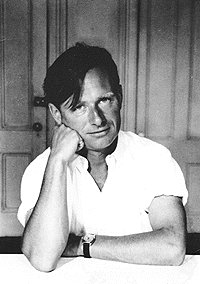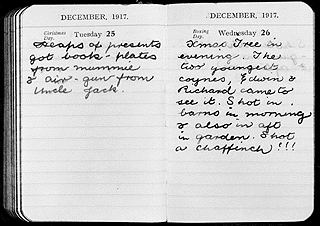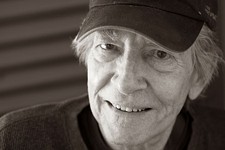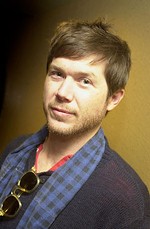Christopher Isherwood
The Diaries
By Clay Smith, Fri., April 4, 1997
|
|
In 1929 the English poet Stephen Spenders wrote The Temple, a veiled autobiographical story of a young poet's heady experiences in Weimar, Germany among the liberated Children of the Sun, the generation so called only for their hedonistic years preceding the Nazi domination of Germany. But Spender didn't publish the book until 1988; his introduction to The Temple is a sort of literary tardy slip: "Two years ago, John Fuller (whom I now thank) told me that during a visit he had made to the United States he had read in the Rare Books section of the Humanities Center of the University of Texas the manuscript of a novel by me. It was called The Temple, and was dated 1929. I wrote at once to the Librarian for a xerox of this. A few weeks later, a young lady appeared at my London house with a bundle under her arm, which contained a copy of the novel. I had completely forgotten that in 1962, during some financial crisis of the kind to which poets are liable, I had sold the manuscript to Texas." Spender's friend Christopher Isherwood, who is caricatured in The Temple along with W.H. Auden and photographer Herbert List, would sympathize with Spender's poetic financial crises, given the evidence the recent publication of the first volume of his diaries provides.
Though some of his papers are at the Harry Ransom Humanities Research Center (HRHRC) at the University of Texas at Austin, Isherwood never dealt directly with the institution for the relief of his financial woes in exchange for manuscripts, correspondence, notes, or even seemingly insignificant paper trails, as did Spender. From all the evidence, in fact, Isherwood was never interested in publishing his diaries or in selling his papers to an archive. It was most likely Isherwood's younger brother, Richard, who sold certain of Isherwood's and their mother Katherine Isherwood's diaries to Bertram Rota, a London firm famous for dealing in 20th-century literary properties. The HRHRC then bought these items in 1990 from the firm. The HRHRC has made its standing eminent among library collections due partially to the fact that in the late Fifties, Ransom realized that because of its relatively late start in acquiring properties, it must make a name for itself by pursuing living as well as dead authors' papers, at the time something of an unheard-of strategy. (HRHRC director Thomas Staley has whimsically noted of Ransom, "Like many collectors, his eyes were larger than his purse. Given the length of his purse, you can imagine the size of his eyes.") In doing so, the HRHRC left many other collectors and archival institutions far behind. In fact, so well-known did the HRHRC become for buying living authors' papers that John Kirkpatrick, the HRHRC's curator of 20th-century American and British literature, notes that at certain places throughout the HRHRC's literary collections, a reader can find remarks from one writer urging another to save even the most obscure papers because, while few others would consider such properties worthwhile, Texans certainly would.
The Isherwood Collection, in its present incarnation, consists of folders upon folders of materials -- correspondence with the Bowleses, John Lehmann, and Tennessee Williams among others, and the typescript for the 1962 novel Down There on a Visit. But the most fascinating relevance the collection holds in light of the publication of the Christopher Isherwood Diaries: Volume One, 1939-1960 (edited by Katherine Bucknell, HarperCollins, $40 hard), which covers just over two decades, is its possession of two of Isherwood's pre-1939 diaries (the rest of which are lost) and all of Katherine Isherwood's diaries.
Now why would a scholar who wants to research a writer some still refer to as Auden's friend find the writer's mother's diaries useful, and why would the HRHRC pay money for them? Christopher Isherwood, perhaps most well-known for Goodbye to Berlin (and the numerous plays and films it inspired, such as Cabaret) was also one of this century's first literary investigators of the distinction between fact and fiction, and the role that autobiography can play in fictionally recreating a certain time and period. The diaries he kept throughout his life were witness to this development.
|
|
Katherine Isherwood taught her son about diary-keeping, writing from Christopher's dictation at the age of six The History of My Friends, a little book the only surviving passage of which possesses the pacing and precision Isherwood would later employ in his novels: "I first met Arthur Forbes in December 1909 when we returned from Frimley to Marple. He was just going to be four. He made up all sorts of wonderful things that he meant to do when he was five, just as if five was when you were grown up."
In turn, Isherwood's diaries distill a reader's understanding of his fiction, open up the German and British exile and expatriate world of Los Angeles from the early Forties until Isherwood's death in 1986, and show a thinker who, though Auden admiringly found him "the cruelest and most unscrupulous person he had ever met," experienced friendships with a warmth diametrically opposed to the coldheartedness many intellectuals, whether through pretense or ideology, harbor. And their publication refutes the cogency of a typically axiomatic statement T.S. Eliot makes in a 1929 essay on Dante -- that "an elaborate preparation of historical and biographical knowledge [about a poet] has always been to me a barrier." The barrier for Eliot is one to scholarly understanding, but for readers of Isherwood, knowledge of his life unquestionably leads to a fuller comprehension of what Isherwood is depicting in his novels.
Volume one begins dramatically, as Isherwood and Auden set sail from Southampton, England, bound for New York, where Christopher and His Kind leaves off. Having written five semi-autobiographical novels and co-authored three plays with Auden, at 34 Isherwood seemed already to have tackled himself and most, if not all, obstacles thrown in his way. But once on American shores, the Diaries reveal him worried almost immediately about the increasing seriousness of the war situation. Isherwood's thoughts about pacifism fill the first part of volume one: January 20, 1940 reveals him asking "Am I a coward, a deserter? Not according to my standards. If I were told that somebody else had `run away from England,' I should ask, `What did "England" mean to him?' `England' to me meant a place that I stayed away from as much as possible during the past ten years. From a strictly patriotic standpoint, you can be `disloyal' in peace as well as in war. Yet no one blamed me then. And I certainly can't blame myself." This "wanting to get away from censoring England" was a sensation not unique to Isherwood; in fact, this reaction to a large part was the cement solidifying the expatriates and exiles who had already started fleeing to Los Angeles, centering themselves around the film industry and the many pleasurable accouterments of Los Angeles.
Near the beginning of The Temple, Spender has Simon Wilmot, the Auden character, say this about his friend William Bradshaw, aka Isherwood: "I send everything I write to Bradshaw. I accept his judgement Absolutely. If he approves of a poem I keep it, if he dislikes one, I scrap it instantly. Bradshaw is Incapable of Error. He is the Novelist of the Future." The reason Wilmot thinks him so essentially important is for his perception that a contemporary novelist must know "the physiology as well as the psychology of his characters." To put it more clearly, Isherwood's avant-garde disturbance of the previously well-maintained line between fact and fiction set him in the vanguard of literary talent. But that rank did not always seem to follow Isherwood; the fame he garnered for Goodbye to Berlin and the numerous plays and films it inspired acted to overwhelm recognition of his other works.
The diaries' publication cannot single-handedly transform Isherwood's underrated status (the entry for September 11, 1958 finds Isherwood ruminating over the fact that "Gore regards me, also, as a neglected writer of quality, so he feels a bond between us."). But they can illuminate what happens to make a writer's life events -- his "raw material" -- become fiction and the diaries' evenhanded, measured prose of over 20 years' observation show Isherwood crystallizing thoughts that would later enter his fiction. As the endlessly thorough editor of the Diaries, Katherine Bucknell writes, "Isherwood goes well beyond simply recording what happens. He tries persistently to understand what his record means." And he uses the diaries to spur himself on, to discipline himself in and out of writer's block, as this fairly representative entry from April 1957 illustrates: "Dissatisfied with myself. The novel is at a standstill -- and why? Because I have gotten into this hair-splitting perfectionistic mood in which I piddle for weeks over a few pages. I must realize that this is just another draft, and get the hell on with it." The diaries are a confidante, as we see in the entry for August 23, 1958: "Slight depression -- because Don [Bachardy, Isherwood's companion for the last 33 years of his life] is staying away tonight, because I don't really want to go to San Francisco tomorrow, because we shall be seeing Thom Gunn there, and I'm jealous of him. All this is foolishness, of course. And it only represents one aspect of how I'm feeling. But as I can't tell anyone about it, I may as well write it down. I can tell Don how I feel about him, so I needn't write that." Bachardy thinks this easy, straightforward tone one of the rewards of reading Isherwood's diaries, because it evinces a side of Isherwood not experienced in his fiction. It is in defiance, almost, of the practiced nature of his published prose.
But if the diaries serve as Isherwood's resting place, his opportunity to write without refinement, how can they also be the springboard from which he culls characters that they so evidently are? Don't the diaries have to occupy some middle ground between scribbling and polished writing? The locus for this middle ground is found in Isherwood's descriptions of his friends and environment, descriptions that are detailed and evocative, but terse enough to merely convey his point and nothing more. Take, for example, Isherwood's recollection of a visit to Abiquiu, New Mexico and Georgia O'Keefe's residence: "Remember how Georgia had a cat which used to catch rats and eat only the heads, leaving the other half for the kittens. So Georgia kept the half rats in the icebox till they were needed. (A good scene: two drunken people raiding the icebox. One of them nearly eats the rat.)" Or this February 1956 anecdote: "Yesterday evening we had supper at John Gielgud's. He described the hideous boredom of a stag dinner party at the Russian embassy. Some visiting Soviet official was doing a lightning cultural tour of Britain. He didn't know who John was. He asked John, `What is your country?' and John, out of mischief, said, "Poland," (his ancestors being Polish). "And what is your theater?" the Soviet official asked. "I haven't got one," John answered modestly -- whereat the Soviet official decided that he must be a person of no importance." There is a disciplined brevity to these observations; Isherwood does not let himself dawdle on insinuating conjecture. They are the product of a novelist practicing when he is supposedly playing.
|
|  |
| Pages from Katherine Isherwood's diaries: The round, child-like but neat printing from 1959 (l) evinces calm whereas the July 1940 (r) shows her ill-at-ease with her son's exile status. | |
A similar drive to rid himself of all extraneous words is evident in Isherwood's spiritual writing. The Diaries are full of references to Quakers, Ramakrishna, the Hindu holy man regarded as an incarnation of God, whose devotees included in addition to Isherwood the philosopher Gerald Heard and Aldous Huxley, and Swami Prabhavananda, a Hindu monk of the Ramakrishna Order, and the founder of the Vedanta Society of Southern California. The diaries find Isherwood constantly seeking spiritual purity, and in fact Isherwood was considering becoming a monk from early 1943 to April 1944. This may help explain passages like this one from May 1951, which surprise the reader only for the incongruity with which they are placed in the midst of more practical concerns: "Oh Master; let me know the peace of doing your will. Help me to stop judging, criticizing, hating. Help me to know and live within your love."
That incongruity, is, of course, the point; for Isherwood, spritual concerns were not set aside as somehow loftier than quotidian worries. They were part and parcel of his waking existence. Like Ludwig Wittgenstein's remarks in his journal of sorts, Culture and Value, Isherwood's spiritual notes possess an incendiary self-honesty, a desire above all else to be at peace with his actions. Isherwood's thoughts on April 27, 1951 perfectly exemplify this inward clarity: "What I really am trying to run away from is myself. What I am trying to impose -- under the disguise of `reasonableness' -- is my own will. `Nothing burns in hell except the self,' and I am miserable because the self is burning. In the simplest, most terrible manner I am being taught that no other kind of life is possible for me. The monastery is here, is wherever I am. When Swami said: `Ramaskrishna will hound you,' he wasn't kidding."
Still, those qualities are not usually ones associated with someone who quickly comes across in volume one of the Diaries as a central social figure of the expatriate community, someone continually at ease in the company of some of this century's most famous artists and thinkers. The reader gradually becomes accustomed to thinking of the Huxleys as Aldous and Maria, and, more oddly, of the Stravinskys as Igor and Vera (Bachardy recalls, "We were so smug.").
Reading Isherwood's Diaries makes one aware of the unique power inherent in possessing a comprehensive personality like Isherwood's, one that is fully content being alone but also demands society, and not only to keep loneliness at bay. His is a personality that disappoints the reader when he writes, in August 1950, "That's enough about myself."
Christopher Isherwood Diaries: Volume One, 1939-1960 (edited by Katherine Bucknell, Harper Collins, $40 hard) is to be followed by two more volumes which will cover, respectively, the years 1945-47, left out of volume one, and 1960-83, three years before Isherwood's death, when, after 60 years, he stopped making diary entries.
Thanks go to the Harry Ransom Humanities Resource Center for their help in accessing Isherwood materials. The general public can access HRHRC holdings by filling out a readers' application form on the fifth floor of the HRHRC building on the UT campus."Confrontations," an exhibition of Don Bachardy's portraits is on display at the Leeds Gallery on the UT campus until August 15.











